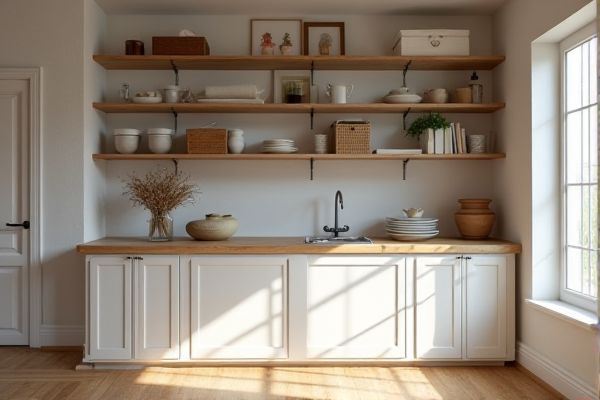
Open shelving provides easy access and visibility for your kitchen items, creating an airy and spacious feel, while closed cabinets offer concealed storage that keeps clutter hidden and protects contents from dust. Discover which storage solution best suits your style and needs by reading the rest of the article.
Table of Comparison
| Feature | Open Shelving | Closed Cabinet |
|---|---|---|
| Visibility | Fully visible items | Items hidden behind doors |
| Accessibility | Easy and quick access | Requires opening doors |
| Storage Capacity | Limited to displayed items | Maximized storage space |
| Dust Protection | No protection, gathers dust | Protects items from dust |
| Aesthetic | Open, airy, modern look | Clean, organized appearance |
| Maintenance | Requires frequent cleaning | Less frequent cleaning |
| Cost | Typically lower cost | Usually higher cost |
| Best Use | Display decorative items, easy access | Conceal clutter, protect valuables |
Introduction to Open Shelving vs Closed Cabinets
Open shelving offers easy access and visual display of items, enhancing kitchen aesthetics and promoting organization by encouraging minimalism. Closed cabinets provide concealed storage, protecting belongings from dust and creating a clean, streamlined appearance ideal for a clutter-free environment. Your choice between these options depends on preferences for accessibility, style, and maintenance needs.
Aesthetic Appeal: Modern vs Traditional Looks
Open shelving offers a modern aesthetic with a clean, airy feel that highlights curated decor and kitchenware, creating a visually spacious environment. Closed cabinets provide a traditional look by concealing clutter and allowing for uniformity in design, contributing to a more polished and orderly appearance. Choosing between open shelving and closed cabinets depends on whether the desired style emphasizes contemporary openness or classic, structured elegance.
Storage Capacity and Organization
Open shelving offers easy access and visibility, ideal for frequently used items but typically provides less overall storage capacity compared to closed cabinets. Closed cabinets maximize storage space with adjustable shelves and hidden compartments, allowing for better organization and protection from dust and clutter. Your choice depends on whether you prioritize quick access or maximizing storage and maintaining a tidy appearance.
Accessibility and Convenience
Open shelving offers immediate visibility and easy access to your kitchen essentials, making it ideal for frequently used items and quick meal preparation. Closed cabinets provide a clutter-free appearance while protecting contents from dust and grease, enhancing long-term cleanliness and organization. Choosing between the two depends on your preference for convenience versus protection in your kitchen workflow.
Cleaning and Maintenance Needs
Open shelving requires frequent dusting and organization to maintain a clean appearance, as items are exposed to air and debris. Closed cabinets protect contents from dust and spills, reducing the frequency of cleaning inside storage spaces. Maintenance for closed cabinets primarily involves wiping surfaces and hinges, making them more practical for long-term cleanliness.
Cost Comparison: Budgeting for Your Space
Open shelving typically costs less than closed cabinets due to fewer materials and simpler installation, making it a budget-friendly option for kitchen renovations. Closed cabinets, while more expensive, offer better protection against dust and damage and can add value to your home with a more polished look. When budgeting, consider long-term maintenance and durability alongside upfront costs to determine the best fit for your space.
Durability and Longevity
Open shelving typically exposes items to dust and potential damage, which may reduce the durability of stored goods, while closed cabinets provide superior protection against environmental factors, enhancing the longevity of both storage and furniture. Materials used in closed cabinets, such as solid wood or laminate with protective finishes, often withstand wear and tear better than open shelves, which can suffer from warping or sagging over time. Choosing closed cabinets can help maintain your kitchen's overall durability, ensuring your storage solution lasts longer with minimal maintenance.
Impact on Room Appearance and Space Perception
Open shelving enhances room appearance by creating an airy, spacious feel and allowing decorative items to serve as focal points, which visually expands the space. Closed cabinets offer a streamlined, clutter-free look that can make a room appear more orderly and cohesive but may visually reduce the sense of openness. The choice between open shelving and closed cabinets directly affects spatial perception, with open designs promoting an open, inviting atmosphere and closed units providing a more enclosed, structured environment.
Best Applications: Kitchen, Living Room, and Beyond
Open shelving excels in kitchens by providing easy access to frequently used items and showcasing decorative dishware, ideal for small spaces or minimalistic designs. Closed cabinets offer superior storage in living rooms, keeping clutter out of sight while protecting valuables and electronics from dust and damage. Beyond these areas, open shelving suits home offices and creative studios for display and organization, whereas closed cabinets are preferred in bathrooms and bedrooms to maintain privacy and conceal personal belongings.
Choosing What’s Right for Your Home
Open shelving offers easy access and a visually light, airy feel that works well in smaller kitchens or for displaying frequently used items. Closed cabinets provide concealed storage, protecting your belongings from dust and creating a streamlined, clutter-free look ideal for larger kitchens or homes seeking a minimalist design. Your choice depends on balancing aesthetics, practicality, and how you use your space daily.
 homyna.com
homyna.com